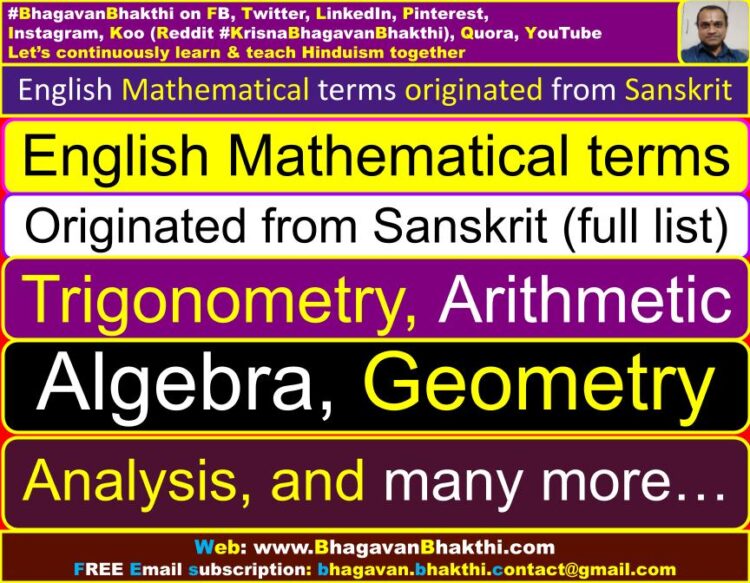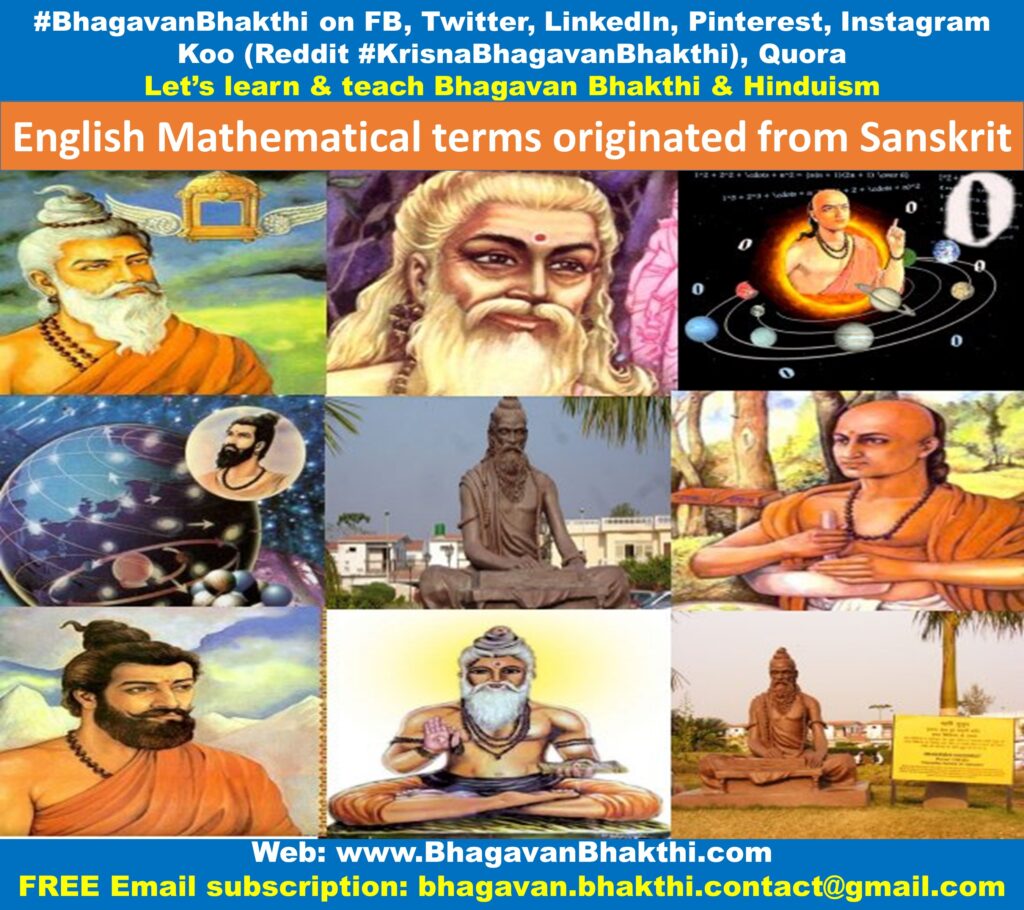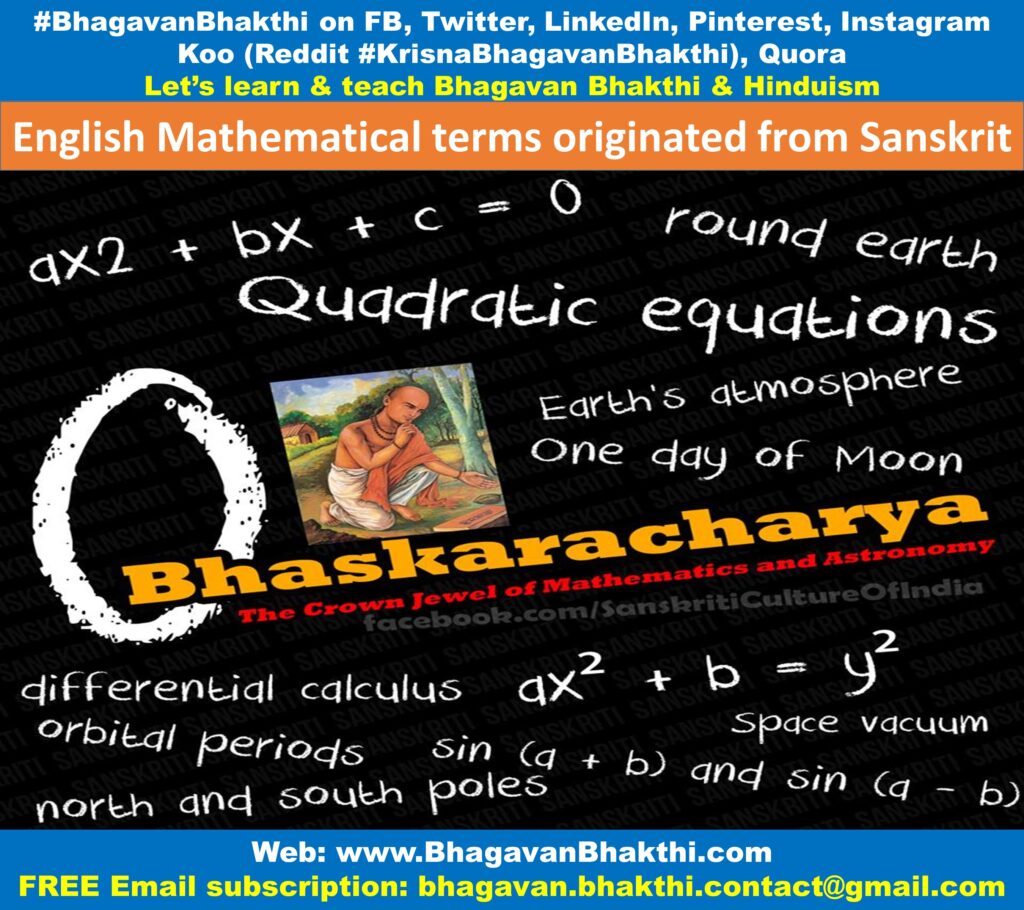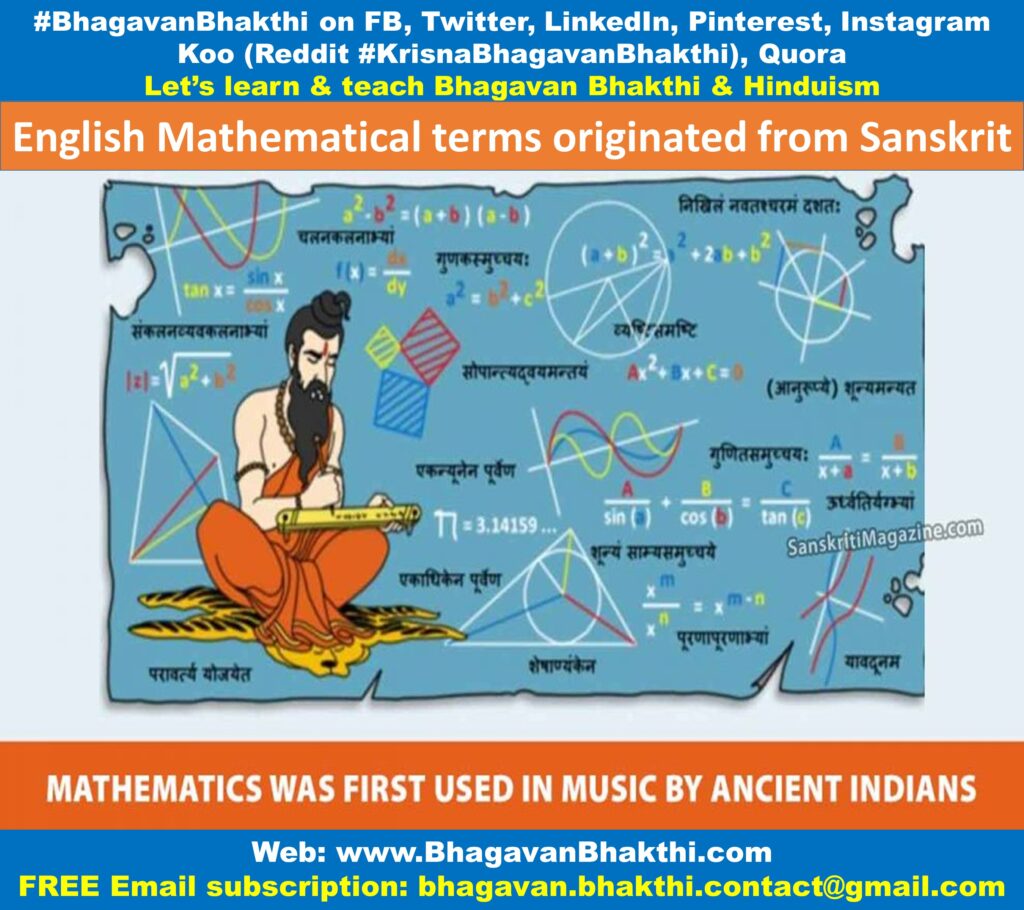English Mathematical terms originated from Sanskrit (full list) | Which Sanskrit words are related to Mathematics | Which word originated from Sanskrit for trigonometry, Arithmetic, Algebra, Geometry, Analysis?
Namaste friends, how are you doing today? Welcome to #BhagavanBhakthi website / blog.
Bhagavan Lord Sri Vishnu (Krishna) (Rama) blessings to you and your family!
In this website / blog, you will always learn about #Hinduism #Sanskrit language.
Also subscribe to my YouTube channel from this link #BhagavanBhakthi to view videos about #Hinduism #Sanskrit language.
Just before going to “English Mathematical terms originated from Sanskrit (full list) | Which Sanskrit words are related to Mathematics | Which word originated from Sanskrit for trigonometry, Arithmetic, Algebra, Geometry, Analysis?“, let us have some brief information.

I have always been thinking that all the languages around the world are nothing but a part and parcel of the Sanskrit / Samskruta bhasha (language).
I have found out that from the North America to Japan, Africa to China, Middle East to Latin (South) America,
in fact all the languages around the world are nothing but Sanskrit / Samskruta bhasha and only difference is that of the pronunciation.
For example many of us know that the English words like ‘mother’ has originated from the Sanskrit word ‘mathru’.
Similarly ‘brother’ came from ‘bhrata’, again ‘father’ came from ‘pithru’ and many many many words are there.
Similarly words like ‘No’, ‘Sugar’, ‘Mouse’, ‘Owl’, ‘New’ etc. came from Sanskrit words ‘na’, ‘sakkara’, ‘mushaka’, ‘olluka’, ‘naveena’ etc.

Let us understand few of such Mathematical terms which are directly or indirectly taken (means mispronounced words) from the Samskruta / Sanksrit bhasha by the world:
1. Math / Maths: We all know maths is a mind using subject and not easy for all.
In few Indian languages we use the word Matih / Mati.
For example you have lost your Matih / Mati – means lost control of mind (in Sanskrit mind means manaha / mann)], that is, a job can be done using the mind.
With this we can understand that the English word Maths is directly derived from Sanskrit word Manaha and Mati.
Is as simple as anything. If you have good Mati you will understand this quickly.
2. Calculus: In Maths we have a beautiful subject / chapter called Calculus. We should be very proud that the birth place of Calculus is Bharata / India.
In Sanskrit the word used is Kalana. Calculus: Cal + cu + lus = Ca + la + cu + lus = Kalana.
3. Trigonometry: Bharata / India is proud for the invention of the Trigonometry.
In Sanskrit Trikonaamaapana is the word used. Trigonometry = Tri + go + no + metry = Tri + ko + na = Trikona + Miti.
Trikona in Sanskrit means Three angles. Means Trigono + metry = measurement of three angles.
4. Triangle: Triangle is a corrupt version of the Sanskrit word Trikona.

5. Pentagon: Pentagon is a corrupt version of the Sanskrit word Panchakonam / Panchakona / Panchakon / Panchkon.
6. Hexagon: Hexagon is a corrupt version of the Sanskrit word ShasTakonam / ShasTakona / ShasTakon.
ShasTakon = Shas + Ta + kon = Has + Ta + kon = Hex + Ta + kon = Hexagon.
7. Heptagon: Heptagon is the corrupt version of the Sanskrit word Saptakonam / Saptakona / Sapnakon.
Saptakon = Sap + ta + kon = Hep + ta + gon = Heptagon.
8. Octagon: Octagon is the corrupt version of the Sanskrit word AsTakonam / AsTakona / AsTakon.
AsTakon = As + Ta + kon = Oc + Ta + gon = Octagon.
9. Nonagon / Nanogon: Nonagon / Nanogon is a corrupt version Pfizer the Sanskrit word Navamakonam / Navakonam / Navakona / Navakon.
10. Decagon: Decagon is a corrupt version of the Sanskrit word Dashakonam / Dashakona / Dashakon.
11. One: is the corrupt and simple form of the Sanskrit word Vandu / Vande.
Vande = Van + de = One + de = One. Vande in Sanskrit has another word called Ekam / Eka / Ek.
Even in many Indian languages we use this word like in Kannada ‘ondu’, in Tamil ‘onna’, in Telugu ‘okati’, in Malayalam ‘onn’. That’s the greatness of the Sanskrit bhasha.

12. Two: Two is the corrupt form of the Sanskrit word dvitiya / dwitiya / dvi / dwi. Here we should note that Europeans can’t pronounce harder words easily.
Like here the Sanskrit word starts from ‘da’. Pronouncing ‘ta / Ta’ is easier compared to ‘da’.
Again here Europeans have made the Sanskrit word more simpler. dvitiya / dwitiya / dvi = dwi = twi = two.
13. Three: Three is the corrupt form of the Sanskrit word Tri. Example is, we call Lord Shiva as Trinetra as He has three eyes.
14. Four: Chatur is the Sanskrit word which means four. Chatur = Cha + tur = Cha + fur = Cha + four = Four.
So it can be noted that Europeans pronounciation of Sanskrit words are different and they need lots of effort to spell Sanskrit words.
15. Five: In Sanskrit Pancha / Panch means five. Panch = Pan + ch = Fan + ch = Fav + ch = Fanch = Five.
Europeans pronounciation is different from our Sanskrit (Indian) pronunciation.
16. Six: Six is the simple form of the Sanskrit word ShasTi. ShasTi = Shas + Ti = Sas + Ti = Sax + Ti = Six. Europeans can’t handle tongue twister.
17. Seven: In Sanskrit seven means Sapta. Think like an European and spell. You will get the answer.
18. Eight: In Sanskrit AshTa means eight. AshTa = Ash + Ta = Esh + Ta = EshTa = Eight.
19. Nine: Navama or just Nava or Nav is the Sanskrit word for Nine. Easily it can be understood it is a corrupted word.
20. Ten: Dasha / Dash / Das is the Sanskrit word for ten. Dash = Tash = Tas = Tes = Ten. Evolution.
21. Eleven: It is the simple form of the Sanskrit word Ekadasha. Eka means one and Dasha means ten.
This explanation we will get clearly from the number thirteen (13), etc. A real tongue twister is the Sanskrit word Ekadasha.
22. Twelve: Twelve is the simple form of the Sanskrit word Dvadasha. Try to pronounce like an English person.
Dvadasha = Tvadasha. From the numerical word thirteen we will understand the similarity.
23. Thirteen: Travodasha is the Sanskrit word for Thirteen. Travo in Sanskrit means three and dasha means ten (refer the earlier words of three and ten). Travodasha = Thirteen.
24. Fourteen: Chaturdasha means fourteen in Sanskrit (refer four and ten as explained earlier).
25. Fifteen: Panchadasha means fifteen. Refer five and ten as explained earlier.
26. Sixteen: Shodasha means sixteen. Refer six and ten as explained earlier.
27. Seventeen: Saptadasha means seventeen. Refer seven and ten as explained earlier.
28. Eighteen: AshTadasha means eighteen in Sanskrit. Refer eight and ten as explained earlier.
29. Nineteen: Navadasha means nineteen in Sanskrit. Refer nine and ten as explained earlier.
30. Twenty: Vimshati means twenty in Sanskrit. Vimshati = Vim + sha + ty = Twen + sha + ty = Twenshaty (Twi/Dwi/Dvi means two & dash means ten) = Twenty.
Twenty is the simple form of Vimshati in Sanskrit. Like this the numbers twenty one, twenty two etc go on and on.
31. Addition / Add: In Sanskrit the word is Adhikatha means Addition / Add.
Also Adhikam / Adhika / Adhik is also an another word which can be used. Very clearly addition / add is a corrupted word.
32. Subtraction / Subtract: Shodhayati / Shodhana is the Sanskrit word. Very very close word. Just a small tongue twister.
33. One o’clock would be Ekavaadanam – एकवादनम्।
2 o’clock : Dvivaadanm – द्विवादनम्।
3 o’clock : Triivaadanm – त्रिवादनम्।
4 o’clock : Chaturvaadanm – चतुर्वादनम्।
5 o’clock : Panchavaadanm – पञ्चवादनम्।
6 o’clock : Shadvaadanm – षड्वादनम्।
7 o’clock : Saptavaadanm – सप्तवादनम्।
8 o’clock : Ashtavaadanm – अष्टवादनम्।
9 o’clock : Navavaadanm – नववादनम्।
10 o’clock : Dashavaadanm – दशवादनम्।
11 o’clock : Ekaadashavaadanm – एकादशवादनम्।
12 o’clock : Dvadashavaadanm -द्वादशवादनम्।
34. Quarter (English) / Quartus (Latin): Quarter = Qua + ter = Chua + tur = Chatur = Quarter.
In Sanskrit Chatur means four (4) and also Chatur is used to divide one into four parts (1/4).
Thus the English word Quarter is mis-spelled word from the Sanskrit word Chatur.
35. Axis (English) / Axon (Latin): Sanskrit word ‘Aksha’ means Axis. Just like we must have heard in Mathematics the x-axis, y-axis etc.
Purely the Sanskrit is the most magnificent language.
36. Corner: Konam / Kona / Conam / Cona is the Sanskrit word.
37. Direction: Disha is the Sanskrit word.
38. Distance: Dooram / Doora / Door is the Sanskrit word.
39. Scale: To scale the fish we have the word ‘sakala / shakala’.Sakala is also consisting of parts divisible.
40. Geometry: We have a very nice word in Sanskrit called jyAmitIya (jyaamitiiya) which means geometry in English.
Translations (branch of mathematics dealing with spatial relationships) French: géométrie German: Geometrie Italian: geometria Russian: геометрия Spanish: geometría Geometry in English.
41. Measure: mApana and mAtra are two Sanskrit words used for the English word measure.
Both the Sanskrit words are elaborated words and not easy for Europeans to pronounce.
Translations (quantity etc. compared to a standard) French: mesure German: Maß Italian: misura Portuguese: medida Russian: мера Spanish: medida
42. Long: In Sanskrit ‘lamba’ means long. lamba = lam + ba = lan + ga = lam + ba = lamba.
Translations (having much distance from one point to another) French: long German: lang Italian: lungo Portuguese: longo Russian: длинный Spanish: largo
43. Centime / centimeter / cent: A former subunit of currency equal to one-hundredth of the franc (cent), centime means the one-hundredth in time and centimeter is the one-hundredth of the metre.
In Sanskrit shatam / shata / shat means one hundred.
44. Decimal / Decagon / Decade: All these English words have one similarity. What is that? Here it is. All these words have 10 – ten in them.
In Sanskrit ‘dasha’ means ten. All these English words are derived from the Sanskrit word ‘dasha’.
45. Equal: In Sanskrit ‘eka’ means same or one. Equal = Ekval.
Translations (the same in all respects) French: égal German: gleich Italian: uguale, pari Portuguese: igual Russian: равный Spanish: igual
46. Limit: There should be a limit for everything is the meaning here.
In Sanskrit ‘miti’ is the word used for limit. Very easily understandable that the English word limit is derived from the Sanskrit word miti.
Translations (boundary) French: limite German: Grenze, Begrenzer Italian: limite Portuguese: limite Russian: предел Spanish: límite
47. Metre / meter: The basic unit of length in the International System of Units (SI: Système International d’Unités).
Metre means some limit of distance. In Sanskrit we have the word ‘miti’ which has the same meaning. Another corrupted word.
Translations (unit of length) French: mètre German: Meter Italian: metro Portuguese: metro Russian: метр Spanish: metro
48. Double: In Sanskrit ‘dvaita / dvi /dvigunA’ means double.
Translations (Made up of two matching or complementary elements) German: doppelt Italian: doppio, doppia Portuguese: duplo Russian: двойной Spanish: doble
49. Full: In Sanskrit full means ‘pUrna / pUrn’ (read as poorna / poorn). Here pUrn = poor + n = foor + n = full.
Europeans pronunciation is quite different from Sanskrit (Indian) pronunciation.
Translations (containing the maximum possible amount) French: plein German: voll Italian: pieno Portuguese: cheio Russian: полный Spanish: lleno pronounciation.
50. Date: In Sanskrit day means ‘tithi or tith’. tith = date = deth.
Translations (fruit of the date palm) French: datte German: Dattel Italian: dattero Portuguese: tâmara Russian: финик Spanish: dátil
51. Negative: In Sanskrit negative means ‘nakArAtmaka / nakArAtmak’. Please see the first four alphabets in Sanskrit word and match with English word.
Nega = nakA. Translations (not positive or neutral)
52. Angle: In Sanskrit angle means ‘aGgula / aGgul’ (read as agnagula / agnagul) or simply ‘angula / angul’.
In earlier days we were using our fingers to measure many things including angle(s). That’s why aGgul in form is angul (angul also means finger).
Translations (geometrical figure) French: angle German: Winkel Italian: angolo Portuguese: ângulo Russian: угол Spanish: ángulo
53. Cycle / circle: In Sanskrit cycle / circle means chakra. Both the English words have been derived from the Sanskrit word.
54. First: In Sanskrit first means ‘pratamam / pratama / pratam’. Earlier many times we have seen that Europeans use ‘fa’ instead of ‘pa’ as used in Sanskrit.
If first is rewritten in Sanskrit style, it would be look like ‘fast’ (this is not english fast / speed) and not first.
55. Question: In Sanskrit question means ‘prashna / prashnam’. Question = ques + tion = prash + nam. ques = prash. Only change is mispronounciation and nothing else.
56. Fraction: In Sanskrit one of the meaning of the english word fraction is ‘paramabhAgam / parambhAg’ (read as pramabhaagam / parambhaag).
Earlier many a we have seen that ‘fa’ is been used in english words when ‘pa’ is been used in Sanskrit. Again another corrupted and mispronounced word.
57. Square: In Sanskrit square means ‘samachaturazra’. Here sama means same, chatur means four and azra means side.
We need to understand that europeans can’t pronounce this type of long words easily. Thus they would cut down the longer word into shorter word.
Thus samachaturazra became square. Give importance to the first and last part of the Sanskrit word.
58. Omega: The twenty-fourth letter of the Classical and the Modern Greek alphabet, and the twenty-eighth letter of the Old and the Ancient Greek alphabet, i.e. the last letter of every Greek alphabet.
Uppercase version: Ω; lowercase: ω.The end; the final, last or ultimate in a series.
(I am the Alpha and the Omega, the First and the Last, the Beginning and the End.— Revelation 22:13, New International Version).
THIS IS SELF EXPLANATORY. NO NEED FOR ANY FURTHER EXPLANATION.
59. AM – Anti meridian: Arohanam maartaandasya
60. PM – Pre meridian: Pathanam maartaandasya
61. Periphery: Sanskrit word is ‘parimaa’.
62. Perimeter: Sanskrit word is ‘parimaapana’.
63.
More information will be added to this on regular basis, please visit after some time to know more information.
I have found out numerous such kind of English and other languages words which are directly or indirectly taken from Sanskrit / Samskruta.
The link for the same is as given below:
English words taken from Sanskrit
To watch videos on #Hinduism #Sanskrit language, SUBSCRIBE to my YouTube channel from this below link:
#BhagavanBhakthi YouTube channel
To know more about “Mahabharata information, facts, details, significance, importance, etc.“, kindly click the below link:
Mahabharata information, facts, details, significance, importance, etc.
Dear friends, if you need any clarifications about this post, kindly let me know, I will definitely try to answer all of them.
Also your one LIKE, one COMMENT, One Share, one SUBSCRIPTION is highly important.
This will help to know the quality of this content and also it will be helpful to know if any improvements is required for the content.
If you feel this content is useful to you and has helped you to improve your knowledge, kindly share this with your well-wishers.
Because “SHARING MEANS CARING”.
To receive FREE EMAIL SUBSCRIPTION about #BhagavanBhakthi, you can send an email to bhagavan.bhakthi.contact@gmail.com from your email ID.
NAMASTE!
Sri Gurubhyo Namaha
Sri Krishnaaya Namaha
Sri Krishnaarpanamastu
Good post! Thanks!
Thank you for your sharing. I am worried that I lack creative ideas. It is your article that makes me full of hope. Thank you.